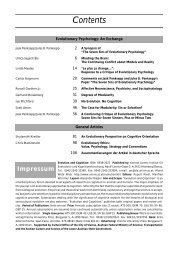Contents - Konrad Lorenz Institute
Contents - Konrad Lorenz Institute
Contents - Konrad Lorenz Institute
Create successful ePaper yourself
Turn your PDF publications into a flip-book with our unique Google optimized e-Paper software.
Steven M. Platek<br />
genes in relatives two-steps removed (e.g., nieces,<br />
nephews, and grandchildren), which provides indirect<br />
support for the notion that, during human evolution<br />
investment decisions not only in a male’s<br />
own children, but also in his kin’s children and<br />
grandchildren, may have been dependent upon a<br />
resemblance perception mechanism/module.<br />
Some other hypotheses about how our ancestors<br />
might have assessed resemblance include the water<br />
reflection hypothesis; i.e., our ancestors might have<br />
been able to see themselves in reflections on the water’s<br />
surface (Gallup, personal communication)—in<br />
fact chimpanzees have been observed investigating<br />
their images in pools of water and urine (KEENAN,<br />
GALLUP/FALK 2003). This hypothesis, although intriguing,<br />
is highly unlikely for three reasons: first,<br />
rarely is water so still that one can stare at it and<br />
gather accurate information from one’s reflection<br />
and, moreover, the probability of still waters occurring<br />
on a regular basis was probably also rare. Second,<br />
a reflection of water is skewed by any motion<br />
in the water and by the distortion due to murkiness.<br />
Third, an adequate account of the reasoning for<br />
why our ancestors would have benefited from contemplating<br />
their existence while staring in the water<br />
has yet to be developed. Further, it has been postulated<br />
the possibility that the water reflection hypothesis<br />
was a driving force behind the selection<br />
against mirror self-recognition among gorillas, stating<br />
that gorillas who stayed by the water side long<br />
enough to contemplate their own existence were at<br />
greater risk of predation by water-dwelling predators<br />
such as crocodilians and reptiles.<br />
Another hypothesis has to deal with proprioceptive<br />
responses and suggests that an individual might<br />
get information about the way he or she looks by 1)<br />
touching his or her own face and 2) by internal visceral<br />
proprioceptive responses from the underside<br />
of the face. Both seem plausible in light of the fact<br />
that the somatosensory system is highly connected<br />
to the visual cortex and that the human brain creates<br />
visual maps associated with tactile information<br />
(e.g., MACALUSO/FRITH/DRIVER 2000; see also<br />
HAUBER/SHERMAN 2001) for discussions of self-referent<br />
phenotype matching). Although these alternative<br />
hypotheses are tenable, recent neuroimaging<br />
(fMRI) data suggests the presence of fundamental<br />
neurocognitive sex differences in reactions to children’s<br />
faces as a function of resemblance (PLATEK et<br />
al., under review). It is likely that resemblance was<br />
assessed via a number of sensory channels in the ancestral<br />
environment and may incorporate a number<br />
of the hypotheses that have been generated. Additionally<br />
however, PLATEK, et al. (under review) have<br />
recently demonstrated sex differences in neural activity<br />
as a function of children’s faces based on resemblance.<br />
Unlike females, who showed activation<br />
typical of mental state attribution, males demonstrated<br />
activity in the left frontal lobes in areas associated<br />
with inhibition on negative responding.<br />
These findings suggest that males may posses a generalized<br />
skepticism about children that is alleviated<br />
when they detect resemblance.<br />
Paternal investment is likely affected by variables<br />
other than resemblance as well. For example, birth<br />
order has also been suggested as being related to the<br />
degree and amount of abusive acts by the father<br />
(DALY/WILSON 1984). An individual born early in<br />
the birth order is less likely to incur abuse at the<br />
hand of the father. This phenomenon should be<br />
predictable to the extent that each additional child<br />
represents 1) an instance of male ambiguity regarding<br />
the paternity of that particular child, 2) the effects<br />
that ambiguity about paternity has on his confidence<br />
of the paternity of his other children, and 3)<br />
an increased draw on his economic resources. Every<br />
time a male’s mate gives birth to a child, the likelihood<br />
that the child shares genes in common with<br />
him is approximately 50% (i.e., the child is either<br />
his or not, but males are probably more certainty because<br />
the rate of EPP is estimated at 1–20% the likelihood<br />
that a child shares genes in common with<br />
him might be more like 80–99%). For example, each<br />
additional child means increased psychological<br />
strain for the male in the form of mate guarding,<br />
suspicion of infidelity, physiological and behavioral<br />
energy in the form of sperm competition and semen<br />
displacement, allocation of resources and also having<br />
to assess resemblance again. Furthermore, if the<br />
male determines that subsequent children do not<br />
share genes in common with him, he may begin to<br />
question the paternity of his other children and engage<br />
in abusive behaviors or ultimately abandon the<br />
family in order to pursue alternative reproductive<br />
opportunities.<br />
Finally, resource allocation as a function of number<br />
of offspring may related to offspring viability.<br />
The more resources a parent invests in a child, the<br />
higher the probability of that child reaching sexual<br />
maturity. BECKER (1991) and DALY/WILSON (1984)<br />
theorize that parents can maximize their investment<br />
benefits by discriminate investment according<br />
to age of offspring and quality of offspring. They<br />
suggest that, under situations of environmental depravity<br />
it would be most beneficial to invest in older<br />
offspring because they have the highest probability<br />
Evolution and Cognition ❘ 192 ❘ 2003, Vol. 9, No. 2








